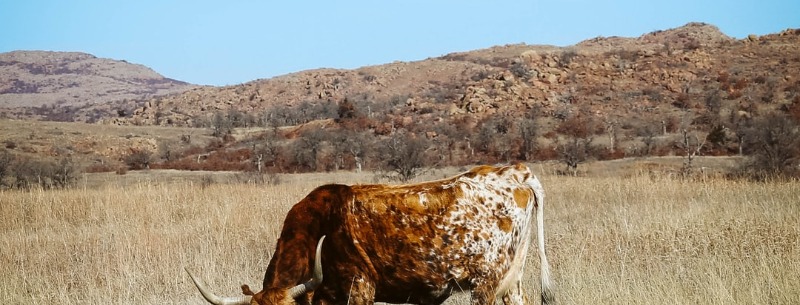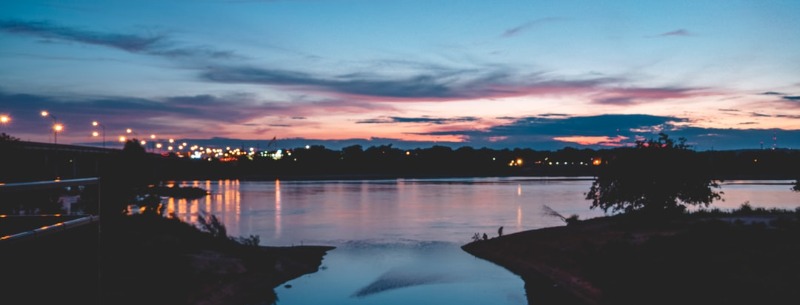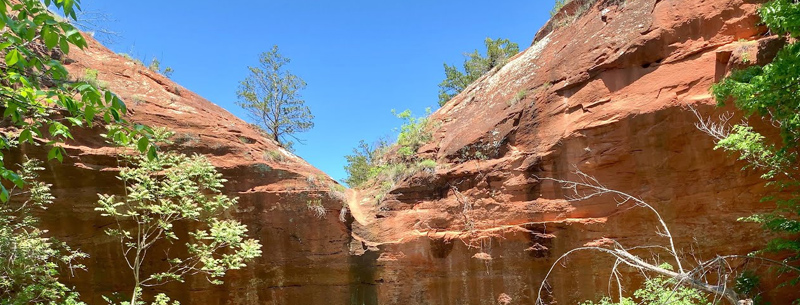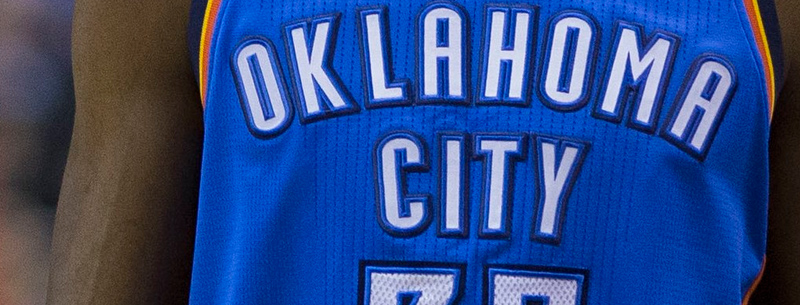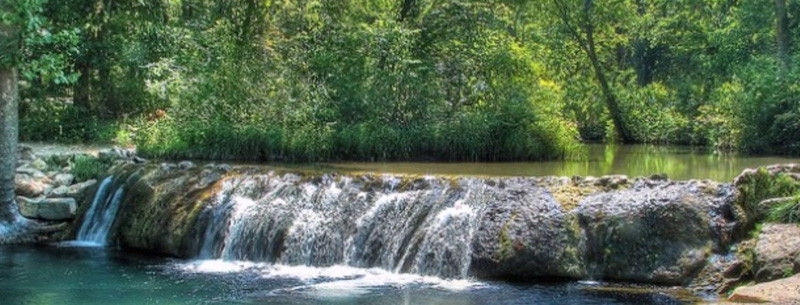2024 Oklahoma Visitors Guide
Oklahoma has a deep-rooted Native American history. In fact, the name Oklahoma was derived from two Choctaw Indian words: Okla meaning people and humma meaning red. Once the land of Cowboys and Indians, the state has kept detailed documentation of its cultural history in museums, such as the Gilcrease Museum in Tulsa and the National Cowboy Hall of Fame and Western Heritage Museum in Oklahoma City.
With state parks, mountains, plains, and forests, Oklahoma’s landscape is almost as varied as its culture. Rising sharply from the grassy plains in West Oklahoma are ancient mountains that extend southwest, providing a haven for outdoor recreational enthusiasts, especially in Fort Cobb Lake State Park. Also of interest is the Museum of the Great Plains in Lawton, which features exhibits about the cattle industry and the fur trade. In East Oklahoma, Claremore boasts the Will Rogers Memorial Museum and Birthplace, as well as the Woolaroc Ranch, Museum and Wildlife Preserve in Bartlesville.
Whether you have the studious museum seekers or the risk-taking rollercoaster riders, kids love Oklahoma. There is so much for them to see and do in every corner of the state. Hotels, museums, amusement parks and all sorts of other attractions take the time to make sure their youngest guests have a blast. You won’t have to worry about long car rides, either. It is difficult to throw a rock without hitting something interesting or unusual in Oklahoma. Roadside historical markers tell of the history of that area. With highways that crisscross the state, there are plenty of stops for everyone. Turn off a major highway onto a state highway and find something you might have missed – something you can smile about for years to come.
Areas of Oklahoma
West Oklahoma Visitors Guide
Comprising the vast area west of Oklahoma City and bordered by Texas and Kansas, West Oklahoma features two distinct regions—the majestic and rugged northwest panhandle and the alluring tapestry of the great plains in the southwest corner of the state. Whether exploring Western cowboy heritage and Americana, rich Native American culture, or the state’s vast recreational spaces, each region offers its own unique appeal. Characterized by geographic diversity, West Oklahoma is dotted with small mountain ranges, wide-open plains, and charming towns overflowing with attractions and genuine hospitality.
Along the northern panhandle, a collection of small towns offer unique opportunities to suit any interest, such as the kid-friendly attractions of Enid, outlying refuges and parks, or Western-infused culture in towns like Guymon and Woodward, where rodeo events and country fairs are paramount. In Oklahoma’s southwest region, museums provide glimpses into the past, including the Museum of the Great Plains and Comanche National Museum and Cultural Center in Lawton, and the curios-filled Oklahoma Route 66 Museum in Clinton. While exploring the historic Route 66, a stop in Weatherford will delight history buffs, aerospace and jazz enthusiasts alike, where exhibits at Stafford Air and Space Museum or concerts at the annual Southwestern Oklahoma State University Jazz Festival are offered. For authentic flavors and fun, vineyards and casino gaming make Anadarko an ideal destination.
East Oklahoma Visitors Guide
Some might say East Oklahoma is where the West begins. Bordered by Arkansas to the east, it is here that wooded hills turn to roll prairies, where the birthplace of Will Rogers enshrined a cowboy culture and what was originally called the Indian Territory before statehood gave way to oil barons. The National Historic Trail of Tears can be witnessed in Tahlequah at the Cherokee Heritage Center and the oil boom that followed has its heart in Bartlesville, which is home to the region’s first oil well as well as Frank Lloyd Wright’s only skyscraper. From archeological sites to prairie preserves and bison, the area east of Tulsa and Oklahoma City hints of the West to come. Even the iconic Route 66 passes through both Claremore and Chandler, the latter of which hosts an interpretive center dedicated to the historic highway.
Before the prairie begins, however, East Oklahoma shows its Southern roots. Muskogee’s festivals, Checotah’s Civil War battle site, stately homes, and the Ozark Mountains remind visitors that the South is close by. The whole region is also known for its fair share of lakes, rivers, and state parks. In fact, over a million acres of wilderness means it is a favorite destination for weekend getaways, fishing, hiking, and hunting. Eufaula Lake and Broken Bow Lake both feature hundreds of miles of shoreline, canoe rentals, and sandy beaches, and the Talimena Scenic Drive is a National Scenic Byway that is particularly popular during the fall foliage season..
Green Country
It’s hard to stay out of the water on a Green Country vacation. Anglers, boaters, windsurfers, scuba divers—all are drawn to the beauty and fun of our lakes and rivers. Each lake has its own style, but all offer plenty of ways to enjoy it. Eastern Oklahoma’s natural beauty is a backdrop for a myriad of man-made attractions that will appeal to every member of your family.
There’s plenty to celebrate in Green Country, with fairs and festivals galore. Enthusiasm and hospitality are traits for which Oklahomans are famous. From charming small towns to cosmopolitan cities, the natives here love visitors. Your heart will warm to this part of the country where friendliness remains a way of life. Entertainment and cultural opportunities abound—you can plan a whole vacation around Green Country’s museums alone. A number of world-class museums house collections with an impressive array of cultural treasures. Small museums tucked away across Green Country offer unexpected treasures that delight and inform.
Things to do in northeast Oklahoma
- Visit the Marland’s Grand Home in Ponca City. E.W. Marland moved to Oklahoma in 1908, in hopes of striking oil. Three years later in 1911, Marland finally struck oil on his 101 Ranch. The home has Oklahoma’s first indoor swimming pool.
- Visit Prairie Song, a few minutes from Dewey. Slip back into the past as you walk the streets of this reproduction of a pioneer town in Oklahoma.
- Stop in at Foyil and see the world’s largest totem pole at Totem Pole Park.
- You will also be able to see The Fiddle House which is home to hand-carved fiddles. Admission to the park is free.
- Spend the day at the Oklahoma Aquarium in Jenks. Learn about creatures of the ocean as well as fish native to Oklahoma.
- Visit the Hayes Family Ozark Stream and see the raccoons, otters, and beavers native to this area of Oklahoma.
- Children will love spending time at the Kiddie Park in Bartlesville. Admission to the park is free. However, the tickets for the rides designed for children cost a quarter. Most of the rides take only one ticket.
- Go golfing at Forest Ridge in Broken Arrow. This 18-hole public golf course is open year-round. Schedule an appointment with one of their golf pros for private lessons.
Oklahoma’s rich multitude of Native American cultures will fill your heart. As you travel through Green Country, our Indian beginnings are evident in the names of our cities, towns, streets, and ports. Boasting more Native American residents than any other state, you’re likely to find a powwow on almost any weekend. Oklahoma means Cowboys, too! With ranches, rodeos, trail rides, and Wild West shows, your whole family will thrill to the action. Your Green Country vacation will always be remembered as an enriching experience.
When’s the best time to visit Green Country? Any time! From spring’s earliest burst of redbuds and azaleas to autumn’s spectacular Indian Summer foliage displays, the scenery will dazzle you. Even winter is a good bet in our mild climate.
Arbuckle Country
Arbuckle Country is located in south-central Oklahoma. It is home to Oklahoma’s oldest state park, Lake Murray State Park. Take a turn unto the past as you visit the Arbuckle Mountains. Enjoy the many splendors Arbuckle country, formerly known as Lake and Trail Country, offers its visitors such as museums, fishing, boating, hiking, and, yes, even scuba diving. Take part in the many festivals and exhibits in this region of Oklahoma. Arbuckle Country has some of the most beautiful forests in the state.
Things to do in south-central Oklahoma
- See the Murray Lindsey Mansion Historical Site in Lindsey. This mansion, made of solid rock, was built in 1879. Enjoy the guided tours or make reservations to book the mansion for private parties.
- Spend the day at The Goddard Center in Ardmore. Enjoy the internationally recognized exhibits that promote both visual arts and performing arts.
- Visit the Gene Autry Oklahoma Museum in Gene Autry. This former schoolhouse is now dedicated to the memories of the singing cowboys. See movie posters, toys, and LP records.
- Go wine tasting at the Valley Vineyards and Winery in Pauls Valley. Sample Oklahoma wines such as Hummingbird Sweet White and Mockingbird Blush.
Great Plains Country
Welcome to Great Plains Country in southwest Oklahoma. Known for the Wichita Mountains, this region of Oklahoma offers a variety of landscapes and attractions. Slip back in time and experience the pioneer days, back when Oklahoma was young and wild. Enjoy the charm of historical sites and the Native American culture this area of Oklahoma is famous for. Meet the folks on the city’s and town’s Main Streets to see why Great Plains Country is well worth the visit. Walk the same streets that outlaws, bootleggers, and lawmen walked when Oklahoma was still Indian Territory. See the ghost towns that were once thriving boomtowns where wildcatters made their fortunes in black gold.
Things to do in Southwest Oklahoma
- Take a tour of the Oklahoma Route 66 Museum in Clinton. Take a look at all the souvenirs collected along Route 66 in the “The World’s Largest Curio Cabinet” exhibit.
- Go back in history when you visit Indian City, USA in Anadarko. Enjoy watching Native American dancing and the tours of seven Plain Indian villages.
- See The Harris sparrow can be seen at Beaver Creek Nature Trails in Waurika. Known as “The Pride of Waurika,” Waurika Lake is home to miles of trails where visitors can see all sorts of native wildlife such as deer, rabbits and many species of birds.
- View the artwork and learn about the pioneer life of the “Sagebrush Artist,” Augusta Corson Metcalfe at the Metcalfe Museum in Durham.
This immense prairie once teemed with wildlife—massive herds of buffalo grazed on the thick grass, and huge flocks of migratory birds frequented vast wetland areas. Many of the species were threatened with extinction but through careful conservation, buffalo once again roam the plains of the Wichita Mountain Wildlife Refuge while pelicans and sandhill cranes are among the visitors to thousands of acres reclaimed from agricultural use in the Hackberry Flats Wetland Restoration Project. Interpretative programs, nature programs, and self-guided tours at these two sites as well as programs at the state parks in the region offer opportunities for an enriching family vacation.
Ancient mountain ranges—the Quartz Mountains and the Wichita Mountains—stand in sharp contrast to the open expanse of the plains. Shimmering blue in the distance, the Wichitas appear out of nowhere, thrust from the flat earth. Mount Scott, one of Oklahoma’s most prominent peaks, offers breathtaking views of the surrounding landscape that seem to go on forever. The unique beauty of the Quartz Mountains provides the setting for the state’s official school for the arts, the Oklahoma Arts Institute.
The temperate climate of southwest Oklahoma allows visitors to enjoy the outdoors any time of year. Bicycle tours, hiking, hunting, fishing, camping, backpacking, bald eagle watches — all are popular in Great Plains Country. Professional guides can ensure a worry-free trip. The area’s natural beauty has been enhanced by the development of lakes and reservoirs created with the interests of anglers, hunters, boaters, and campers in mind.
The exciting heritage of southwest Oklahoma is rooted in the history of the Plains Indians. The rich traditions of Native American life continue in the many powwows and exhibitions held throughout the year. Galleries, shops, and trading posts across Great Plains Country offer visitors the opportunity to purchase both traditional and contemporary Indian craft items and artworks.
The American cowboy and the great cattle drives of the late 1880s are immortalized in museums, historic sites, and public sculptures such as the inspiring “Crossing the Red” in Altus and the awesome “On the Chisholm Trail” in Duncan. From country and western music to the excitement of rodeo, cowboy culture remains alive and strong in Great Plains Country.
Oklahoma Route 66 Museum
Route 66 has long been a symbol of America’s free-wheeling spirit. Travelers are re-discovering the easy pace, roadside parks, and other remnants of pre-interstate travel along this legendary road. As it cuts across the top of the Great Plains Country, it is honored with two museums. The Oklahoma Route 66 Museum in Clinton and the new National Route 66 Museum in Elk City guide visitors through the colorful history of the “Mother Road” with exciting exhibits and historic artifacts.
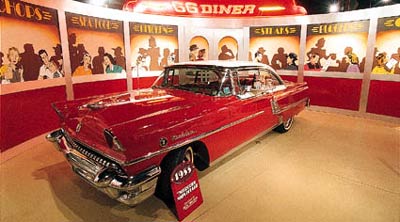
Kiamichi Country
Kiamichi Country, also known as “Little Dixie,” is located in southeastern Oklahoma. It is home to Ouachita National Forest, the only national forest in Oklahoma. Enjoy the beautiful mountains, lakes, and streams that Kiamichi Country has. Visitors are hard-pressed to find a more sportsman-friendly place on the planet then this area of Oklahoma known for hunting and fishing. Guests will love learning the history of this area, dating back to 1012 A.D – long before Columbus discovered America.
Things to do in southeastern Oklahoma
- Visit The Wild Things Farm in Pocola. Go on hayrides, make your way through a corn maze and enjoy the petting zoo. Depending on which season it is when you visit the many activities will change.
- Kayak, canoe or tube down the Mountain Fork River or Little River with Ambush Adventures in Broken Bow. Enjoy the natural beauty of the Ouachita Mountains.
- Visit the Olivet Cemetery in Hugo. Rodeo greats such as Lane Frost and Freckles Brown. Hugo has been the wintering home for many circuses so the cemetery is the final resting place of many circus performers.
- The Ouachita National Forest is a must-see when visiting Oklahoma.
- Take a peek at a cast of the skeleton of a dinosaur at The Museum of the Red River in Idabel. You will also be able to see archaeological artifacts from the Choctaw and Caddo Indian tribes as well as African and East Asian cultures.
- Test your golfing skills at the Arrowhead State Golf Course in Canada. This challenging 18-hole course is beautiful against the backdrop of Lake Eufaula.
- Visit the Krebs Heritage Museum in Krebs. Learn the history of this city that is older than Oklahoma and the immigrants that made Krebs possible.
Frontier Country
Central Oklahoma, from Stillwater to Purcell and from west of El Reno to just east of Prague, is known as Frontier Country. This area is overflowing with activities and attractions. The Greater Oklahoma City Metropolitan area is located in Frontier Country so great shopping, exciting museums and loads of outdoor activities abound. Guthrie, Oklahoma’s first capital is also located in this region of Oklahoma for all the history buffs out there.
Things to do in central Oklahoma
- Just 30 minutes from Will Rogers World Airport you will find Riverwind Casino. There you will be able to play a wide variety of card games as well as slot machines.
- Get wet and have some fun at White Water Bay in Oklahoma City. Take the plunge from the Acapulco Cliff Dive or float down Castaway Creek.
- Take a walk on the wild side and stop by Tiger Safari in Tuttle. Visit Kiara, the African lioness, and Marcus and Cajun, the American Alligators. Guided by a staff member, you will be able to feed the animals and learn about them and their natural habitats.
- Oklahoma City’s premier hot spot is Bricktown, centrally located in downtown Oklahoma City. Whether you are wanting a night on the town, a quiet dinner or to shop ‘til you drop, Bricktown is for you.
- Go camping, picnicking, or horseback riding at Arcadia Lake, just east of Edmond. More than 25 miles of shoreline promises fun and adventure.
- Take the entire family to Oklahoma City and enjoy Frontier City, Oklahoma’s largest amusement park. Ride the “Eruption,” Oklahoma’s tallest thrill ride or take a trip around the park on the “Ol’ 89er Express.”
If you are looking for a family-friendly outing or a wild night on the town, Frontier Country has something to offer everyone. The breathtaking scenery and its friendly, down-home people are sure to make your visit to Frontier Country everything you wanted. Make memories that last a lifetime as you visit Frontier Country, in the heart of Oklahoma.
Vacation Destinations in Oklahoma
Oklahoma City Visitors Guide
Once a barren prairie, Oklahoma City became a prosperous modern-day city practically overnight when the unassigned land was opened to white settlement. Today the oil industry is a major contributor to its prosperity, as well as Stockyards City, which is the largest stocker and feeder cattle market in the world. Oklahoma City is the epicenter of Oklahoma, situated directly in the middle of the state, making it an ideal capital city. The State Capitol Building grounds are uniquely Oklahoma, with the world’s only working oil well beneath a state capitol. Oklahoma City has also had its share of tragedy: the memory of those lost in the bombing of the Alfred P. Murrah Federal Building in 1995 will remain in the hearts of many for years to come. The Oklahoma City National Memorial stands to remember the 168 lives that were lost. Other Oklahoma City attractions include the National Cowboy Hall of Fame and the Frontier City Theme Park.

Tulsa Visitors Guide
Tulsa is still reaping the benefits of rapid economic growth that began in the early 20th century. On June 25, 1901, when drillers struck oil in Tulsa, the city’s growth and development increased significantly. Oil tycoons were quickly drawn to Tulsa to take part in the wealth. The city has continued to progress and today it is Oklahoma’s second-largest city. Tulsa has earned the nickname Green Country due to the large number of parks and gardens in the area, including the Tulsa Garden Center, where a number of garden types and an arboretum are found.
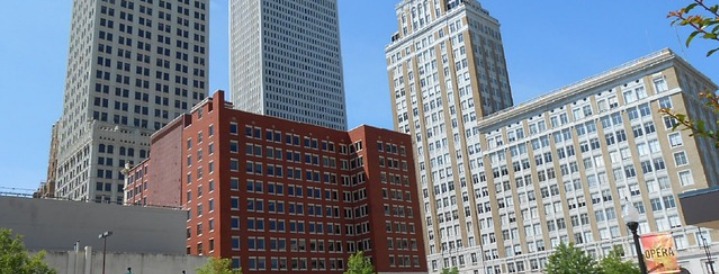
One of Oklahoma’s finest museums is Tulsa’s Gilcrease Museum, which displays more than 10,000 American West artworks dating from colonial times to the present, as well as an archival and anthropological collection. The Philbrook Museum of Art is an Italian Renaissance villa that is surrounded by gardens and holds a varied collection of artworks within.
Oklahoma History
Oklahoma’s recorded history began in 1541 when Coronado’s search for the “Lost City of Gold” brought him through what would later become Oklahoma. That same land was part of the 1803 Louisiana Purchase. The United States government relocated the Five Civilized Tribes to this area beginning in the 1820s. The “Trail of Tears” is the most famous forced march of the Cherokee from their homes in the southeastern United States. In time, this became known as the “Golden Age” of the Indian Territory.
Oklahoma became part of the cattle industry after the Civil War ended. This becomes the era of the cowboy. Forced into giving up their collective lands, the Indians were allocated property individually. This was in part due to “Boomers,” who wanted land opened to white settlement. Six different land runs took place between 1889 and 1895. Settlers from all over the United States traveled to the Indian Territory to take part in the land giveaway. Settlers even traveled from all over Europe for this rich land. African Americans, many former slaves of Indians, also participated in the land runs.
Oklahoma became the 46th state on November 16, 1907. Oil was a huge factor in Oklahoma becoming a state. People came from all over the world to the “place to strike it rich” Once the word was out there was black gold under the red dirt of Oklahoma.
